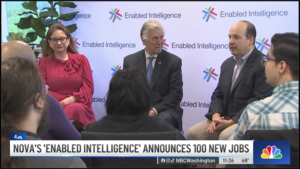by Peter Kant and Kiersten Todt
Can a diverse work be the key to effective AI technology?
The rapid increase in the number of companies that have hired Chief Diversity Officers (CDOs) over the past three years has halted. Companies are now laying off CDOs almost as quickly as they were hired or reducing the budget support for these offices. Individuals who have held these roles are moving into other fields because the roles are disappearing. If we believed this transition were occurring because companies have figured out how to integrate diversity into their operations and that they no longer need an office focused on this effort, then this shift would be a sign of success. We do not believe that is the case. We see the reduced interest in workforce diversity as evidence that more work is needed to explain to skeptical public specifically why diversity matters in our workforce and why it is critical to our growth as a nation and a society.
While diversity of all kinds is critical, one clear but less publicized way in which promoting diversity helps all of society is by engaging neurodiverse individuals in our workforce. As the CEO of Enabled Intelligence, who has worked in tech innovation and R&D, and as the former Chief of Staff of the Cybersecurity and Infrastructure Security Agency, who has worked in cybersecurity since 9/11, we can identify two constants: cybersecurity and tech innovation are about problem-solving and building solutions. To do both effectively, we must engage diversity of thinking, which means we need to include individuals in our workforce who look at problems from various perspectives based on their backgrounds and unique aptitudes.
Since March of this year, Artificial Intelligence has become the center square on everyone’s technology bingo card – and our ability to shape thoughtful, innovative AI demands diversity of thinking.
AI is only as good as the data that goes into it. For example, Large Language Models, or LLMs, like Open AI’s ChatGPT, if comprised of flawed or biased data, will produce flawed or biased results. Reliable data sets for LLMs are difficult to create; we need highly skilled workforces that can develop these data sets. If we agree on these points, then we should be doing all we can to ensure the data is trustworthy and does not have bias.
From our experience developing reliable AI models for critical national security missions, we know that neurodiversity leads to less biased data and that neurodiverse individuals excel at bias identification and elimination. We must therefore aggressively engage neurodiverse individuals in AI development and create workforces that support diversity of thinking. Data annotation and analysis can be most effectively and successfully performed by neurodiverse individuals. Their unique aptitude for detail orientation, pattern recognition, and focus during seemingly repetitive analysis helps ensure the training data used to develop AI models for defense uses is highly accurate and less susceptible to typical human biases. These teams help detect objects others miss, including camouflaged missile launchers and unexploded ordnances in Ukrainian farm land, protecting Ukrainians from potential harm. Their neurodiversity is a “superpower” as they assess millions of satellite images for that “needle in a haystack” detection.
Companies and organizations are desperately seeking talent to meet the challenges of an AI enabled economy. In a recent analysis, the U.S. Chamber of Commerce noted that if every unemployed American instantly took a job, there would still be over 4 million unfilled open jobs in the U.S. Yet, the U.S. Bureau of Labor Statistics shows that the unemployment rate for persons with disabilities is double the overall unemployment rate (7.8 % compared to 3.7%). Why are we leaving these valuable workers on the sidelines?
An Accenture report, “Getting to Equal: The Disability Advantage”, found that there are 15.1 million people of working age living with disabilities in the U.S. The report states that the GDP could get a boost of up to $25 billion if just one percent more of persons with disabilities joined the U.S. labor force. Additionally, the report found that companies that have improved their inclusion of persons with disabilities over time were four times more likely than others to have shareholder returns that outperform those of their peer group.
However, we need to alter our view of individuals with various aptitudes. We do not assert employing individuals with disabilities as a “check the box” exercise, but rather creating more inclusive workforces that represent the demographics of our nation and the world and that lead to a more comprehensive and thoughtful approach to social and economic growth. Inclusivity is critical to our future.
Companies need to prioritize the development and growth of inclusive workforces. Technology innovation and the certain expansion of artificial intelligence demand diversity of thinking, which comes from diversity of race, gender, socioeconomic background, cognitive and physical abilities. If we honor each person for who they are and we do the work to understand what they can offer, we will create highly functional, effective, and, ultimately, revolutionary, workforces.
Our society is not currently structured for that process to happen naturally. Companies need to model, from the most senior executive office, the need and value of a diverse workforce; they must incorporate diversity into their corporate strategy, prioritize it, and assert how it supports their performance, outcomes, and bottom line. We must believe in diversity and engage everyone and each individual’s unique capabilities, competencies, and aptitudes. The pressures to keep up with rapid technological growth, the competitiveness on the global stage, and the hope for the future of our society demand it.







